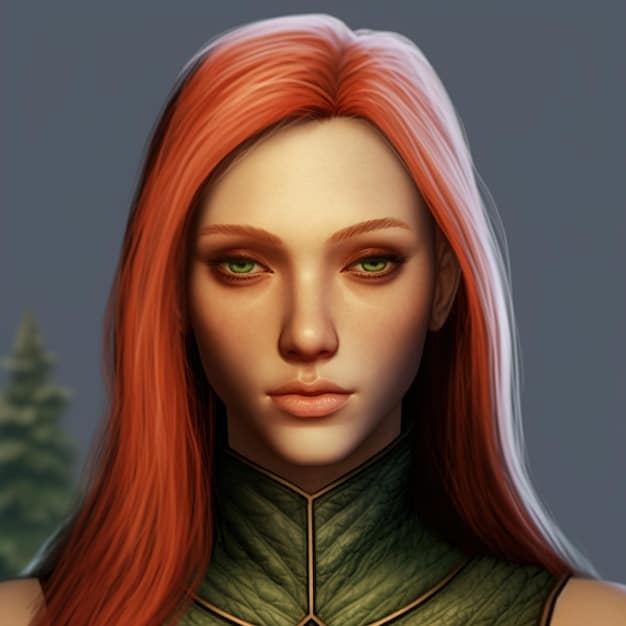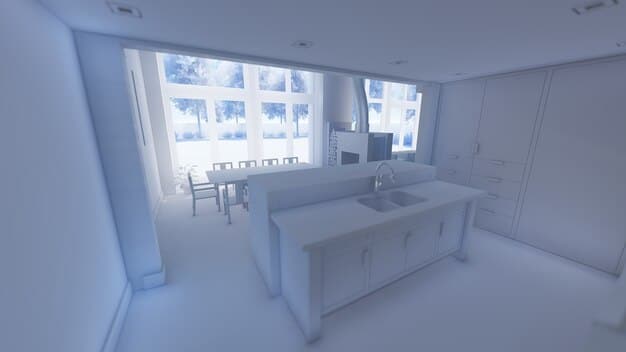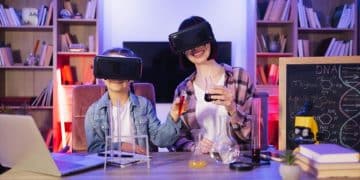NVIDIA Ray Tracing: Visual Fidelity Revolution in 2025

NVIDIA’s ray tracing technology is poised to revolutionize visual fidelity in gaming and other applications by 2025, offering more realistic lighting, shadows, and reflections, significantly enhancing the immersive experience for users.
Prepare to witness a revolution in visual fidelity as NVIDIA’s ray tracing technology: a deep dive into its impact on visual fidelity in 2025 promises to redefine realism in gaming, design, and beyond. Dive in to explore how this innovation is set to transform our digital experiences.
Understanding NVIDIA’s Ray Tracing Technology
NVIDIA’s ray tracing technology is a rendering technique that simulates the way light behaves in the real world. By tracing the path of light rays as they interact with objects in a scene, it creates incredibly realistic lighting, shadows, and reflections. Understanding this technology is key to appreciating its impact.
How Ray Tracing Works
Ray tracing simulates light by calculating the path of individual light rays from a light source, bouncing them off objects, and determining their color and intensity. This process is repeated for millions of rays, creating a highly realistic representation of light in a scene.
The Difference Between Ray Tracing and Rasterization
Traditional rasterization techniques approximate lighting effects, while ray tracing accurately calculates how light interacts with objects. This results in more realistic and nuanced visuals that were previously impossible to achieve in real-time.
- Realistic Lighting: Ray tracing accurately models how light scatters and reflects, creating more realistic and dynamic lighting effects.
- Enhanced Shadows: Shadows are rendered with greater precision, capturing subtle details and variations in darkness.
- Reflective Surfaces: Reflections are more accurate, showing the environment as it realistically appears on reflective surfaces.
- Global Illumination: Simulates how light bounces off surfaces to illuminate other objects, adding depth and realism to scenes.
Ray tracing brings unparalleled realism to computer graphics by simulating the physical behavior of light, setting it apart from traditional rendering techniques. This leap in technology allows for environments and characters to be rendered with a level of detail and accuracy that greatly enhances visual fidelity.

The Evolution of Visual Fidelity: From Pixels to Photorealism
The journey from pixelated graphics to photorealistic visuals has been a long and fascinating one. Ray tracing represents a significant milestone in this evolution, bringing us closer to indistinguishable realism in computer-generated images. Let’s examine how visual fidelity has evolved over the years.
Early Graphics: The Pixel Era
Early video games and computer graphics were characterized by pixelated images and limited color palettes. Simple shapes and blocky textures were the norm due to technological constraints.
The Rise of 3D Graphics
As technology advanced, 3D graphics emerged, offering more complex shapes and textures. However, lighting and shadows were still approximated, leading to less realistic visuals.
- Improved Detail: More complex models and textures became possible, enhancing the visual quality of games and applications.
- Better Performance: Advances in hardware allowed for smoother frame rates and more detailed scenes.
- Artistic Innovation: Developers found creative ways to overcome technological limitations, pushing the boundaries of visual design.
Ray tracing represents the culmination of decades of advancements in computer graphics, promising a future where virtual worlds are virtually indistinguishable from reality. This not only enhances gaming but also has profound implications for design, simulation, and entertainment.
Impact on Gaming: A New Era of Immersion
Ray tracing is transforming the gaming landscape by providing unprecedented levels of visual realism. From lifelike reflections to accurate shadows, ray tracing enhances every aspect of the gaming experience, offering deeper immersion and engagement. This is how ray tracing is revolutionizing gaming.
Enhanced Realism and Immersion
Ray tracing creates more believable game environments, immersing players in worlds that feel more real and tangible. Every detail, from the glint of sunlight on water to the subtle shadows cast by trees, contributes to a more compelling and immersive experience.
Gameplay Advantages
While primarily a visual enhancement, ray tracing can also affect gameplay. Realistic reflections can reveal hidden enemies, and accurate shadows can provide tactical advantages in virtual environments.
Ray Tracing and Competitive Gaming
Ray tracing may not always be favored in competitive gaming due to its performance demands, but it can still offer advantages in visual clarity and environmental awareness.
By 2025, ray tracing is expected to become a standard feature in high-end gaming, offering players a transformative visual experience. This proliferation will not only improve the look of games but also redefine the boundaries of immersion and engagement.
Ray Tracing in Other Applications: Beyond Gaming
While ray tracing is most known for its impact on gaming, its applications extend far beyond the realm of entertainment. Industries such as architecture, automotive design, and film production are leveraging ray tracing to create stunningly realistic visuals. Let’s explore some non-gaming applications.
Architectural Visualization
Architects use ray tracing to create realistic renderings of buildings and interiors, allowing clients to visualize designs before construction begins. This helps in making informed decisions and avoiding costly mistakes.
Automotive Design
Automotive designers employ ray tracing to visualize car models in various lighting conditions, ensuring optimal aesthetics and functionality. Realistic reflections and shadows help designers refine their creations.

Film and Animation
Ray tracing is used in film and animation to create special effects and realistic environments. It enhances the visual quality of movies and TV shows, making them more immersive and engaging.
- Realistic Lighting and Shadows: Ray tracing accurately simulates light behavior, enhancing the visual appeal of films and animations.
- Improved Special Effects: Visual effects are more realistic and seamlessly integrated into scenes.
- Enhanced Detailing: Minute details and textures can be rendered with high precision, adding depth and realism.
As computational power increases and ray tracing technology becomes more accessible, we can expect to see even wider adoption across various industries. This will lead to more realistic visualizations, better designs, and enhanced user experiences across diverse applications.
Challenges and Future Developments
While ray tracing offers significant visual improvements, it also presents several challenges, including high computational demands and the need for specialized hardware. Addressing these challenges is crucial for the widespread adoption of ray tracing. The future of ray tracing holds exciting possibilities.
Computational Demands
Ray tracing requires significant processing power, which can strain even high-end graphics cards. Optimizations and new hardware architectures are needed to improve performance.
Hardware Requirements
Ray tracing is typically supported by dedicated hardware, such as NVIDIA’s RTX series GPUs. This can limit accessibility for users with older or less powerful hardware.
Hybrid Rendering Techniques
Combining ray tracing with traditional rasterization techniques can offer a good balance between visual quality and performance. Hybrid rendering allows developers to selectively apply ray tracing to the most visually impactful elements of a scene.
Future developments in ray tracing are expected to focus on improving performance, reducing hardware requirements, and expanding its applications across various industries. Enhanced algorithms and more efficient hardware will likely make ray tracing more accessible and practical for a wider range of users and applications.
Anticipating NVIDIA’s Ray Tracing Technology in 2025
By 2025, NVIDIA’s ray tracing technology is expected to be even more advanced, offering improved performance, wider accessibility, and greater integration across various platforms. Several key trends will shape the future of ray tracing.
Hardware Advancements
Next-generation GPUs will offer significantly improved ray tracing capabilities, enabling more complex and realistic visuals with minimal performance impact. This will make ray tracing a standard feature for gaming and professional applications.
Software Optimizations
Advanced algorithms and software optimizations will further enhance ray tracing performance, making it more efficient and accessible. This includes better support for hybrid rendering techniques and AI-assisted ray tracing.
- Improved Performance: Ray tracing will run more smoothly on a wider range of hardware.
- Greater Accessibility: More users will be able to experience the benefits of ray tracing.
- Wider Integration: Ray tracing will be seamlessly integrated into various software and platforms.
NVIDIA’s ongoing efforts to refine and democratize ray tracing technology will undoubtedly transform the visual landscape by 2025. This will not only benefit gamers and creative professionals but also drive innovation across industries, making realistic and immersive visuals a new standard.
| Key Point | Brief Description |
|---|---|
| 💡 What is Ray Tracing? | A rendering technique for realistic lighting and reflections. |
| 🎮 Gaming Impact | Enhanced immersion and visual quality in video games. |
| 🏢 Other Uses | Applications in architecture, automotive design, and film. |
| 🚀 Future in 2025 | Improved performance and wider accessibility. |
Frequently Asked Questions
▼
Ray tracing is a rendering technique that simulates the path of light rays to create realistic lighting, shadows, and reflections. It calculates how light interacts with objects in a scene.
▼
Ray tracing enhances gaming by providing more realistic visuals, which include accurate lighting, detailed shadows, and lifelike reflections. This results in deeper immersion for players.
▼
Beyond gaming, ray tracing is used in architectural visualization, automotive design, film production, and animation to create realistic renderings and special effects.
▼
Ray tracing typically requires dedicated hardware, such as NVIDIA’s RTX series GPUs, to handle the high computational demands of the technology. Newer GPUs enhance performance.
▼
By 2025, ray tracing is expected to feature improved performance, wider accessibility, and greater integration across various platforms, thanks to hardware and software optimizations.
Conclusion
As we look towards 2025, NVIDIA’s ray tracing technology is poised to revolutionize visual fidelity in gaming and numerous other applications. With ongoing advancements and broader accessibility, ray tracing is set to redefine our expectations of visual realism, offering immersive experiences that were once only a dream.





